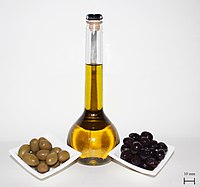
Photo from wikipedia
Virgin olive oil (VOO) classification into quality categories determines its labeling and market price. This procedure involves performing a series of chemical–physical analyses and, ultimately, a sensory analysis through the… Click to show full abstract
Virgin olive oil (VOO) classification into quality categories determines its labeling and market price. This procedure involves performing a series of chemical–physical analyses and, ultimately, a sensory analysis through the panel test. This work explores the analysis of VOOs quality with an electronic olfactory system (EOS) and examines its abilities using the panel test as a reference. To do this, six commercial olive oils labelled as extra virgin were analyzed with an EOS and classified by three panels recognized by the International Olive Council. The organoleptic analysis of the oils by the panels indicated that most of the oils in the study were in fact not extra virgin. Besides this, the classifications showed inconsistencies between panels, needing statistical treatment to be used as a reference for the EOS training. The analysis of the same oils by the EOS and their subsequent statistical analysis by PCA revealed a good correlation between the first principal component and the olive oil quality from the panels using average scores. It also showed a more consistent classification than the panels. Overall, the EOS proved to be a cheaper, faster, and highly reliable method as a complement to the panel test for the olive oil classification.
Journal Title: Foods
Year Published: 2022
Link to full text (if available)
Share on Social Media: Sign Up to like & get
recommendations!